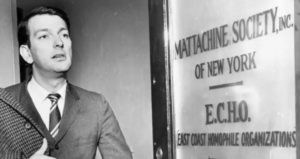Ed Murphy: Gay Blackmailer and Activist – Chapter 8 – Double-Edged Legacy
I last saw Ed at the Christopher Street Festival in June 1988. Several dozen Conference for Catholic Lesbian marchers ended up at our booth in front of St. Veronica’s, we did a brisk business selling tee-shirts, buttons and handing out literature. It was a fun and exhilarating day. By connecting with the group and other Catholic lesbians, visitors were able to start to reconcile, or begin to come to terms with, the struggle of faith and sexuality. What they didn’t think was possible did exist.
Ed died of AIDS on February 28, 1989. His last job was at Trix, a gay hustler and strip bar in Times Square. A brief obituary appeared in section B, page 16 of the March 2, 1989, edition of The New York Times: “Edward Francis Murphy, a leader in the gay rights movement, died Sunday at St. Vincent’s Hospital in Manhattan. Mr. Murphy, who was 63 years old and lived in Manhattan, died of heart failure, said his longtime friend, Richard Mahoney. Mr. Murphy became a gay-rights advocate in the 1960s and founded the Christopher Street Festival, held annually the last week in June. He was the director of the One-to-One program at the Manhattan Development Center, a state institution for mentally retarded and developmentally disabled adults. Surviving are his mother, Dorothy, and a sister, Dorothy King, both of Queens. A memorial service is to be held today at 10 A.M. at St. Veronica’s Roman Catholic Church, 155 Christopher Street.” When Ed was arrested for his role in the “Chickens and Bulls” extortions he was living at 167 Christopher Street, close by St. Veronica’s.
At Ed’s standing-room-only funeral, the priest remarked, “If Ed Murphy is not with God, then there is no God.” As pallbearers carried him to the hearse, a police escort stopped traffic and a tenor sang, “Danny Boy.” His obituary in the New York Native, a popular gay newspaper, described Murphy as “a patriarch to his own,” and said that “bigotry appalled him.” He was, the obituary stated, “a humanitarian with few peers whose like may not pass our way soon.” A few months later, Ed Murphy was named posthumous Grand Marshall of the 1989 New York City Gay Pride parade. The Cadillac Murphy traditionally rode in led the march, empty except for the driver.
I do remember that there was some opposition to him being named Grand Marshall. I didn’t know or can’t recall why some people didn’t want him honored—it was never stated clearly. I didn’t understand why people would object. It seemed to me that he did a lot for the gay community. Because he talked to me about it, I knew that Ed had a rough background between jail and jail violence. He spoke in a gruff, New Yawker way, but he was a good man and tried his best to help people. I appreciated what he did for us, and I was fond of him. At no time did I ever hear in conversation or read in gay papers about the Mafia involvement in Stonewall, or Ed’s past life as an extortionist and blackmailer.
In 1989, there were still lots of people around who knew Ed’s awful history. But not one word was written until author and journalist William McGowan’s ground-breaking article in the Wall Street Journal, “Before Stonewall” published on June 16, 2000; over a decade after Ed’s death. Why didn’t anyone come forward? Why was this information suppressed? Here’s one theory: people were afraid. If Ed was able to skate through the “Chickens and the Bulls” without going to jail—blackmailing rich, influential men—who was protecting him? What and who did he know that kept him walking around free? People who might have acted or spoken out chose discretion to save themselves a bad beating or worse. Whether this influence was true or not people believed that it was true and were afraid of him.
The silence regarding Ed Murphy is reminiscent of the silence surrounding the 1965 murder of Malcolm X. Decades later it came out the NYPD and FBI were involved in keeping track of Malcolm X using Black Muslim informants. Some members of the Nation of Islam also knew who the real killers were but didn’t say anything and let two innocent men be convicted and go to prison. Why? I believe that it was to protect themselves and their families from violence and to protect the reputation of the Nation of Islam. The reluctance that minority groups have toward exposing despicable deeds by their members is a defensive reaction to avoid more contempt and oppression by law enforcement and the public. It was better to forget than pursue justice. Like Ed Murphy, at least one of the killers hid in the open and volunteered for a lot of neighborhood charitable activities.
Ed Murphy had resentments and hostilities of his own, including a class resentment of affluent white men. “I resent the George Segal statue created in memory of Stonewall because those people in the statue don’t represent the people who fought back at Stonewall. Those are Fire Island guys in that statue. Those who fought were drag queens, Hispanics, street people.”
Ed’s statement is true about the Stonewall Riots, but not about Gay Liberation. The latter was mostly the result of large numbers of middle class and affluent whites who came out, organized politically, and demanded change. White gay men, with their contacts and careers in business, law, media, arts, and the entertainment industry pushed hard, particularly with AIDS and later with marriage equality. Back in the late ‘70s, journalist Arthur Bell remarked on the discordant styles of Ed Murphy and the rising cohort of gay activists: “Then there’s his age, and his background, grating against the media image perpetuated by the Dewar’s White Label liberationists. It’s not right for the movement that the boss downtown looks as if he just stepped away from the crap game in Guys and Dolls. That Skull may embody gay liberation is difficult for them to perceive.” And his habit of referring to his “brothers” as “queens, cocksuckers, fags, and worse.”
Ed’s early class consciousness—like Trump era blue-collar resentment of elites—made it easier for him to shake down Wall Streeters and other professional men. He saw them use and discard prostitutes and return to their comfortable if closeted lives. Why not use them to make some money?
On the surface, it appears that after the Stonewall Riots, Ed Murphy experienced a metanoia like St. Paul on the road to Damascus. Before Stonewall, he victimized gay men as part of a money-making scheme; afterwards, he represented himself as one of few Stonewall habitues who really cared about gay rights. He continued to work in gay bars and clubs and expanded his large network of contacts and associates in the gay bar culture. He also became an active volunteer with mentally handicapped and disabled children and adults. By all accounts, he was very gentle and loving with them. Murphy also helped runaways, people with AIDSs and prostitutes who were broke and needed kindness and some cash. “When I was in jail,” he told a reporter, “a lot of people helped me. I’m trying to help somebody back.”
I asked my wife, Dr. Lori Mei, a social psychologist, how Murphy made such a complete change from brute to saint. “I don’t think that he necessarily did,” she said, “he just followed the money. He couldn’t continue to blackmail people; he was too identified at that point, but there was money to be found in charity and gay rights work.” Not as much money as in blackmail, but certainly enough to cobble a living between that and bar work. I think he also took pride in helping people out and was protective of people that he perceived as forgotten, scorned or unwanted.
Ed Murphy never expressed any regret for his role in the “Chickens and the Bulls” extortions or regret for the fear and misery suffered by his victims. Some saints led lives of depravity, but at some juncture expressed remorse for the evil they had done. “I ask Skull if he feels that he’s negating the bad in his life by doing good deeds,” said reporter Arthur Bell, “be it with the gay liberation movement, the crime commission, or the retarded.” “I don’t look at it that way,” Murphy answered. “My past is behind me. I was a crazy kid. I did crazy fucking things. I’m happy with what my life gave me.” Some people acknowledge their responsibility; some justify their misdeeds, others like Ed Murphy shrug them off and move on.
Ed Murphy, the Mafia at the Stonewall, and the “Chickens and the Bulls” scandal are pretty much forgotten today. That’s a shame. The shadowy interactions of these players shaped important episodes in gay, New York, and national history. What happened after Stonewall is the legacy of decades of mistreatment and contempt, and the need for homosexual men and women to lead a double life of quiet desperation. Men could satisfy their need for sex with prostitutes and one-night stands; many women had to be satisfied with close friends and fantasies. For centuries men caught with male prostitutes or decoys have been preyed upon by criminals. Since Ed Murphy procured and pimped, he was in a good position to blackmail.
The Stonewall Riots were a spontaneous public explosion by drag queens, teenagers and bar patrons who were fed up with being pushed around by police and exploited by mobsters. Gay Liberation started back in the 1950s with the Mattachine Society and the Daughters of Bilitis. It was propelled along by the same civil rights currents as the women’s liberation movement and Black Power but flexed a lot of muscle when middle class and affluent whites “came out” and were no longer subject to extortion. Ed Murphy the blackmailer and activist lit the fuse at Stonewall. 
I met Ed Murphy almost 40 years ago. Ed reminded me of my father, a tough Irish city boy who made his own way. Ed was a hard man with a soft heart for people who shared his hardships. But I am also painfully aware of the men that Ed hurt, used, and ruined, especially the long-time Wall Street employees who lost their livelihoods and dignity because of Ed’s blackmail and thievery at Stonewall. “Stonewall” became a liberation icon to lesbians and gays around the world; but to the “old and trusted employees” who were turned out of their jobs on Wall Street because they were gay, and the blackmailed men searching for a way out of their loneliness, “Stonewall” was a source of misery and degradation.
Read the entire article. Ed_Murphy_Gay_Blackmailer_and_Activitist
Primary Sources for this Article
I am deeply indebted and grateful to the following writers for their research, books and articles on Ed Murphy, the Mafia, J. Edgar Hoover, and The Chickens and the Bulls scandal.
Phillip Crawford, Jr., The Mafia and the Gays; Queer Joints, Wise Guys and G-Men. A retired attorney, Crawford is a leading authority on the historic role of the Mafia in gay bars. From 2009 to ? Crawford blogged extensively about organized crime at “Friends of Ours.” The blog was located at http://bitterqueen.typepad.com. One particularly helpful post was “Stonewall Riots: A Gay Protest Against Mafia Bars – June 7, 2010. You can also find him online at https://phillipcrawfordjr.medium.com and his website.
William McGowan, Before Stonewall: Scandal, blackmail, a police crackdown. Shedding light on a forgotten case. The Wall Street Journal, June 16, 2000. The Chickens and the Bulls – The rise and incredible fall of a vicious extortion ring that preyed on prominent gay men in the 1960s. July 11, 2012. Mr. McGowan is a journalist. http://williammcgowan.com
Arthur Bell, “Skull Murphy – The Gay Double Agent. Village Voice, May 8, 1978. Arthur Bell (1939-1984) was a writer, journalist and gay rights activist who lived in New York City. Bell was a founder of the Gay Activists Alliance and wrote for many gay and mainstream papers, including the popular column, “Bell Tells” in the Village Voice.
David Carter, “Stonewall: The Riots that Sparked the Gay Revolution. St. Martin’s Press, 2004. David Carter gave a presentation before the United States Civil Service Commission on the History of the Stonewall Uprising and the LGBT Civil Rights Movement on June 7, 2019. His full statement can be read here – https://www.washingtonblade.com/2019/06/12/u-s-civil-rights-commission-reiterates-support-for-equality-act/
Douglas M. Childs, Ph.D., Professor of History at Penn State University. He has posted thousands of pages of FBI files on gays on his website: https://sites.psu.edu/dougsite/page-2/. He wrote a book, “Hoover’s War on Gays – Exposing the FBI’s ‘Sex Deviates’ Program, University Press of Kansas, 2015.
Anthony Summer, “Official and Confidential: The Secret Life of J. Edgar Hoover.” G. P. Putnam & Sons, 1993. https://www.anthonysummers.com. Summers specializes in investigative non-fiction books.
Karen A. Doherty and Barbara M., Conference for Catholic Lesbians (CCL) members and representatives, spoke and met with Ed Murphy around Gay Pride Day and the Christopher Street Festival – 1983-1988. https://nihilobstat.info/2006/06/10/edward-murphy-of-the-stonewall-inn/
Additional Books, Newspaper Articles, & Blog Posts
Burton Hersh, Bobby and J. Edgar – The Historic Face-Off Between the Kennedys and J. Edgar Hoover That Transformed America, Carroll & Graf Publishers, 2007
Martin B. Duberman, Stonewall, Dutton, 1993
“Detective at Hotel is Held in Extortion,” The New York Times, August 5, 1965.
“Nine Seized Here in Extortion Ring – Hogan Says Gang Preyed on Homosexuals and Others,” by Jack Roth, The New York Times, February 18, 1966.
“Nationwide Ring Preying on Prominent Deviates – Bogus Policemen Victimize Theatrical Figures – Even Reach Into Pentagon,” by Jack Roth, The New York Times, March 3, 1966.
“3 Indicted Here as Sex Extorters – U.S. Charges Ex-Convicts Preyed on Homosexuals,” by Edward Ranzal, The New York Times, June 1, 1966.
“Detective Accused as a Top Extorter,” The New York Times, July 1, 1966.
“Blackmail Paid by Congressman – Victim Among Thousands of Homosexuals Preyed by Ring of Extortionists,” by Jack Roth, The New York Times, May 17, 1967.
“Homo Nest Raided, Queen Bees are Stinging Mad,” by Jerry Lisker, New York Daily News, July 6, 1969.
“Christopher’s Emperor: Mike Umbers,” by Arthur Bell, Village Voice, July 22, 1971.
“Ex-Convict Brings Smiles to the Retarded” by Paul L. Montgomery, The New York Times, March 31, 1975.
“Edward Murphy, 63, A Gay-Rights Leader,” The New York Times, March 2, 1989.
SAGE (Senior Action in a Gay Environment) Newsletter, June 1989, New York, NY.
“Charges of Profit Skimming Roil ’92 Christopher Street Festival” by Peder Zane, The New York Times, June 26, 1992.
“J. Edgar’s Slip Was Showing,” by Murray Weiss, February 11, 1993.
“Partners for Life,” by Sidney Urquhart, Time Magazine, February 22, 1993. A review of the book, Official and Confidential: the Secret Life of J. Edgar Hoover by Anthony Summer.
“The Real Mob at Stonewall” by Lucian K. Truscott IV, The New York Times, June 26, 2006.
“Edward “The Skull” Murphy,” by R. Marc Kantrowitz, The Patriot Ledger, June 24, 2012.
“Half-Century Later, NYPD Apologies for Stonewall,” by Duncan Osborne, GayCityNews.com, June 6, 2019.
“Stonewall – Strange But True,” An Historian Goes to the Movies – Exploring history on the screen. Andrew E. Larsen, https://aelarsen.wordpress.com/2015/10/13/stonewall-strange-but-true/
“The Stonewall Inn,” A Gender Variance Who’s Who, Zagria Cowan, https://zagria.blogspot.com/2011/06/the-stonewall-inn.html#.YL6fyPlKhPZ
“Mafia Exploitation of Kids: Really a New Low?” Five Families of New York City. http://www.fivefamiliesnyc.com/2010/04/mafia-exploitation-of-kids-really-new.html
The website – Not Kansas – particularly “The Gay 60s, 1966-1970″












